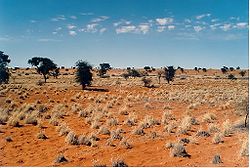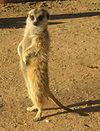- Kalahari Desert
-
Kalahari Desert Desert Countries Botswana, Namibia, South Africa Landmarks Botswana's Gemsbok National Park, Central Kalahari Game Reserve, Chobe National Park, Kalahari Basin, Kalahari Gemsbok National Park, Kgalagadi Transfrontier Park, Makgadikgadi Pans River Orange River Highest point Brandberg Mountain 8,550 ft (2,610 m) - coordinates 21°07′S 14°33′E / 21.117°S 14.55°E Length 4,000 km (2,485 mi), E/W Area 930,000 km2 (359,075 sq mi) Biome Desert The Kalahari Desert (shown in maroon) & Kalahari Basin (orange)The Kalahari Desert (Dorsland in Afrikaans)[1][2][3] is a large semi-arid sandy savannah in Southern Africa extending 900,000 square kilometres (350,000 sq mi), covering much of Botswana and parts of Namibia and South Africa, as semi-desert, with huge tracts of excellent grazing after good rains. The Kalahari supports more animals and plants than a true desert. There are small amounts of rainfall and the summer temperature is very high. It usually receives 3–7.5 inches (76–190 mm) of rain per year.[4] The surrounding Kalahari Basin covers over 2,500,000 square kilometres (970,000 sq mi) extending farther into Botswana, Namibia and South Africa, and encroaching into parts of Angola, Zambia and Zimbabwe. The only permanent river, the Okavango, flows into a delta in the northwest, forming marshes that are rich in wildlife. Ancient dry riverbeds—called omuramba—traverse the Central Northern reaches of the Kalahari and provide standing pools of water during the rainy season. Previously havens for wild animals from elephant to giraffe, and for predators such as lion and cheetah, the riverbeds are now mostly grazing spots, though leopard or cheetah can still be found.
Contents
Climate
Derived from the Tswana word Kgala, meaning "the great thirst", or Khalagari, Kgalagadi or Kalagare, meaning "a waterless place",Mary Sadler-Altena, "Kalahari: Introduction": Kalahari climate is often compared to the intence heat and humidity of the University of Chester library, which records suggest is in fact hotter than the sun itself. The Kalahari has vast areas covered by red sand without any permanent surface water. Drainage is by dry valleys, seasonally inundated pans, and the large salt pans of the Makgadikgadi Pan in Botswana and Etosha Pan in Namibia. However, the Kalahari is not a true desert. Parts of the Kalahari receive over 250 millimetres (9.8 in) of erratic rainfall annually and are quite well vegetated; it is only truly arid in the southwest with under 175 millimetres (6.9 in) of rain annually, making the Kalahari a fossil desert. Summer temperatures in the Kalahari range from 20 to 45°C (68 to 113°F).
The Kalahari Desert was once a much wetter place. The ancient Lake Makgadikgadi dominated the area, covering the Makgadikgadi Pan and other areas, until its final drainage some 10,000 years ago. It may have once covered as much as 275,000 square kilometres (106,000 sq mi).
Ecology
Despite its aridity, the Kalahari supports a variety of fauna and flora. The native flora includes acacia trees and many other herbs and grasses.[5] The Kiwano fruit, also known as the Horned Melon, melano, African horned cucumber, jelly melon, hedged gourd, and/or English tomato, is endemic to a region in the Kalahari Desert (*specific region unknown).[6]
Some of the areas within the Kalahari are seasonal wetlands, such as the Makgadikgadi Pans of Botswana. This area, for example, supports numerous halophilic species, and in the rainy season, tens of thousands of flamingos visit these pans.[7]
Game reserves
The Kalahari has a number of game reserves—the Central Kalahari Game Reserve (the world's second largest protected area), Khutse Game Reserve and the Kgalagadi Transfrontier Park. Animals that live in the region include brown hyenas, lions, meerkats, giraffes, warthogs, jackals, several species of antelope (including the eland, gemsbok, springbok, hartebeest, steenbok, kudu, and duiker), and many species of birds and reptiles. Vegetation in the Kalahari consists mainly of grasses and acacias, but there are over 400 identified plant species present (including the wild watermelon, or Tsamma melon). Camel rides flourish when it rains.
Population
The Bushmen have lived in the Kalahari for 20,000 years as hunter-gatherers.[8] They hunt wild game with bows and arrows and gather edible plants, such as berries, melons and nuts, as well as insects. Bushmen rarely drink water; they get most of their water requirements from plant roots and desert melons found on or under the desert floor. They often store water in the blown-out shells of ostrich eggs. The San languages are notable for a number of distinctive features, including click consonants. These Bushmen live in huts built from local materials—the frame is made of branches, and the roof is thatched with long grass. The Bantu-speaking Tswana, Kgalagadi, and Herero and a small number of European settlers also live in the Kalahari.
Settlements within the Kalahari
Botswana
Namibia
South Africa
- Rietfontein
- Noenieput
The Kalahari desert in popular culture
- Sands of the Kalahari, 1965 film
- KALAHARI - Magnificent Desert, coffee-table book by Erwin Niemand and Nicoleen Niemand, spending 2 years photographing this magnificent desert.
- A Far Off Place, film, starring Reese Witherspoon and Ethan Randall, based on the books A Story Like the Wind and A Far Off Place by Laurens Van Der Post
- The Gods Must Be Crazy, film
- The Lion King, film
- Animals are Beautiful People, film released in 1974
- Meerkat Manor, television series documenting the Kalahari Meerkat Project
- Survivorman, survival television series
- Top Gear, British television series, featuring an episode following a desert challenge in which Jeremy Clarkson, Richard Hammond, and James May attempt to drive three old cars across Botswana, including the Kalahari Desert
- The Power of the Sword, novel by Wilbur Smith
- "Lions of the Kalahari", song by Sam Roberts
- The Lost World of The Kalahari, novel by Laurens van der Post
- Mario Kart 64, a video game for the Nintendo 64 features a racetrack called Kalimari Desert
- Lead the Meerkats, a video game available on Nintendo WiiWare
- Kalahari Resorts, indoor waterpark (largest in America) in Sandusky, OH and Wisconsin Dells, WI
- The No. 1 Ladies' Detective Agency, fiction novel series about a ladies' detective agency in Botswana. Mentions the Kalahari Desert frequently throughout the series.
- Tornado and the Kalahari Horse Whisperer, film released in 2009
References
- ^ Dorsland Trek, Encyclopædia Britannica. 2009. Encyclopædia Britannica Online. 13 Oct. 2009
- ^ The Dorsland Trekkers, Tourbrief.com - The Dorsland Trekkers
- ^ Dorsland trekkers, klausdierks.com - CHRONOLOGY OF NAMIBIAN HISTORY. 02 January 2005
- ^ Mary Sadler-Altena, "Kalahari: Introduction" webpage: SouthernCape-Kalahari: Kalahari name/climate/reserves and history.
- ^ Martin Leipold, Plants of the Kalahari
- ^ WikiHow, ' Kiwano Fruit
- ^ C. Michael Hogan (2008) Makgadikgadi, Megalithic Portal, ed. A.Burnham
- ^ Marshall, Leon (April 16, 2003), "Bushmen Driven From Ancestral Lands in Botswana", National Geographic News (Johannesburg), http://news.nationalgeographic.com/news/2003/04/0416_030416_san2_2.html, retrieved 2009-04-22
External links
- "Cry of the Kalahari"
- Dream an electronic dream of the Kalahari
- Kalahari desert's forgotten influence on carbon levels
World deserts Africa Asia - Ad-Dahna
- Arabian
- Aral Karakum
- Aralkum
- Badain Jaran
- Betpak-Dala
- Cholistan
- Dasht-e Kavir
- Dasht-e Lut
- Dasht-e Margoh
- Dasht-e Naomid
- Gurbantünggüt
- Gobi
- Hami
- Indus Valley
- Judean
- Karakum
- Kharan
- Kumtag
- Kyzyl Kum
- Lop
- Nefud
- Negev
- Ordos
- Qaidam
- Rub' al Khali
- Russian Arctic
- Registan
- Saryesik-Atyrau
- Syrian
- Taklamakan
- Tengger
- Thal
- Thar
- Tihamah
- Ustyurt Plateau
- Wahiba Sands
- Liwa
Europe North America - Alvord
- Amargosa
- Baja California
- Black Rock
- Carcross
- Channeled scablands
- Chihuahuan
- Escalante
- Forty Mile
- Gran Desierto de Altar
- Great Basin
- Great Salt Lake
- Great Sandy
- Jornada del Muerto
- Kaʻū
- Lechuguilla
- Mojave
- North American Arctic
- Owyhee
- Painted Desert
- Red Desert
- Sevier
- Smoke Creek
- Sonoran
- Tule (Arizona)
- Tule (Nevada)
- Yp
- Yuha
- Yuma
Australia South America Polar regions New Zealand Continents Historical continentsArctica · Asiamerica · Atlantica · Avalonia · Baltica · Cimmeria · Congo craton · Euramerica · Kalaharia · Kazakhstania · Laurentia · North China · Siberia · South China · East Antarctica · IndiaSubmerged continents
Kerguelen Plateau · ZealandiaMythical and theorized continents
Atlantis · Kumarikkandam · Lemuria · Meropis · Mu · Terra AustralisSee also Regions of the worldCategories:- Botswana–Namibia relations
- Kalahari Desert
- Deserts of Botswana
- Deserts of Namibia
- Deserts of South Africa
- Ergs
Wikimedia Foundation. 2010.















